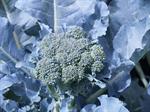Vegetables to Grow in Winter

Vegetables will grow across most of Australia and other mild temperate climates in winter: if you choose the right ones. If you get some frosts, but little or no snow; you can plant in autumn for a winter harvest.
What to Plant in Autumn …for picking in winter or spring (in Australia)
Brassicas – cauliflowers, cabbages, broccoli, brussels sprouts
Swedes and Turnips
Lettuces (some varieties)
Radishes
Onions and Garlic
Peas and Broad Beans
Potato
Spinach & Silver Beet
Parsley
Winter Vegies in the Sub Tropics and Tropics
Lack of warmth is not such a problem in northern Australia over winter.
In fact, with lower humidity than summer, crops like zucchini, tomatoes, lettuce, snow peas and cucumber are often easier to grow over a tropical winter than a tropical spring or summer.
CABBAGE
Plant in a fertile, loose soil (easily dug) with constant moisture (never dry; never really wet). Sow directly into the soil or plant seedlings. Smaller varieties can be spaced at 30 x 30 cm; larger ones at 45 x 45 cm. They grow best when well planted on a mound or grown hydroponically. Ideally maximum temperatures should be above 13 degrees celsius, although some varieties will do better at lower temperatures.
Problems:
*Cabbage White Butterfly grubs must be controlled.
*Other pests can include aphis, flea beetles, maggots and cutworm.
*Cabbage can be attacked by several fungi including fusarium wilt, downy mildew
and alternaria leaf spot.
* Do not plant them beside tomatoes, beans or strawberries.
Harvest & Post Harvest:
*Cut throught the base with a sharp knife when the centre is firm.
*Harvested cabbages can be stored for a month or more at
0 to 3 degrees centigrade and low relative humidity.
Varieties:
*There are varieties available to crop at all times of the year.
TURNIPS AND SWEDES
Require cool conditions are essential for proper development.
Soil must be well drained and have good aeration.
*Avoid heavy gritty / rocky soil; pH 6.0 to 6.5
Suitable systems:
*Hydroponics: Perlite or vermiculite (or a mixture) are likely to give
the best results.
*Broadcast raised soil beds. Sow seed direct.
Problems:
*There are few problems on the edible root, though leaves are often
attacked by insects.
Harvest & Post Harvest:
*2 to 3 months from planting to harvest.
*Cut leaves and wash roots at harvest.
BROAD BEANS
Need cool conditions: hot, dry weather reduces cropping. Nutrient requirements are similar to common beans, although broad beans tolerate higher levels of boron than the common bean.
Problems:
*Aphis can damage tip growth (control with pyrethrum near to cropping,
control with malathion early in the season).
*Excess moisture can cause root rot
Harvest & Post Harvest:
*3 to 4 months after planting
ONIONS
It’s a good time to plant onions, although they are easier to grow from seedlings than from seeds. Ideal temperature range is 13 to 25 degrees Celsius. Onions like a relatively dry situation low humidity, good drainage and aeration and minimal watering
Problems:
*Too much water causes fungal problems.
*Pests include aphis, thrip, maggots and cutworms.
*Diseases include downy mildew, fusarium, botrytis, smut and several other
virus and fungal problems
Harvest & Post Harvest:
*Lift bulb onions after tops die down completely.
*Pull spring onions before tops begin to die down.
You may also be interested in....